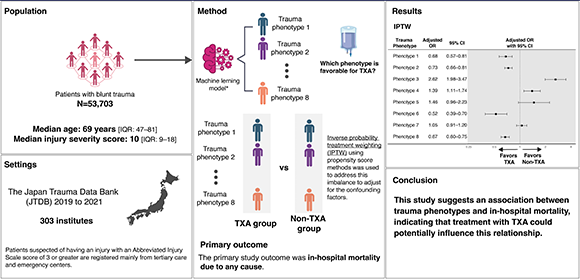
Using machine learning to save lives in the ER
Researchers from Osaka University use machine learning to identify patients more likely to survive traumatic injury if treated with tranexamic acid.
Worldwide, approximately 4.5 million people die of traumatic injury every year. Many of these patients die from blood loss.
Early treatment with a drug called tranexamic acid stops excessive bleeding by reducing the body’s ability to break down blood clots. However, tranexamic acid can cause unnecessary drug side effects in patients who do not need it, so it is necessary to select truly effective target patients based on objective criteria.
Now, in a study published in Critical Care, researchers from Osaka University have addressed this treatment challenge by identifying subgroups of trauma patients who are more likely to survive if treated with tranexamic acid. The team found these subgroups by examining trauma patients who shared similar traits (also known as phenotypes).
“We identified eight different trauma phenotypes, and then we evaluated the benefits of tranexamic acid treatment based on these phenotypes,” explains lead author Jotaro Tachino. “We found subgroups of patients with significantly lower in-hospital mortality when they received tranexamic acid. We also found subgroups of patients who received no benefit from treatment.”
The team used machine learning to help categorize trauma patients into these subgroups. Using this technique, researchers processed information from over 50,000 patients in the Japan Trauma Data Bank and then analyzed patterns associated with trauma, treatment, and survival.
The team found an association between trauma phenotypes and in-hospital mortality, indicating that treatment with TXA could potentially influence this relationship.
The researchers say “Trauma patients are a heterogeneous population with injuries that vary greatly in type and severity. This makes it difficult to predict how effective a treatment will be in an individual patient”. “We hope our results will help individual trauma patients receive more personalized care as well as improve the quality of care for all trauma patients.”
Given the high death toll from traumatic injury, strategies that improve survival are essential for patients and their families. This research is a key step in optimizing tranexamic acid use in trauma patients.
Fig. Research overview
Credit: Osaka University
The article, “Association between tranexamic acid administration and mortality based on the trauma phenotype: a retrospective analysis of a nationwide trauma registry in Japan,” was published in Critical Care at DOI: https://doi.org/10.1186/s13054-024-04871-w
Related Links
Specially Appointed Assistant Professor Jotaro Tachino
